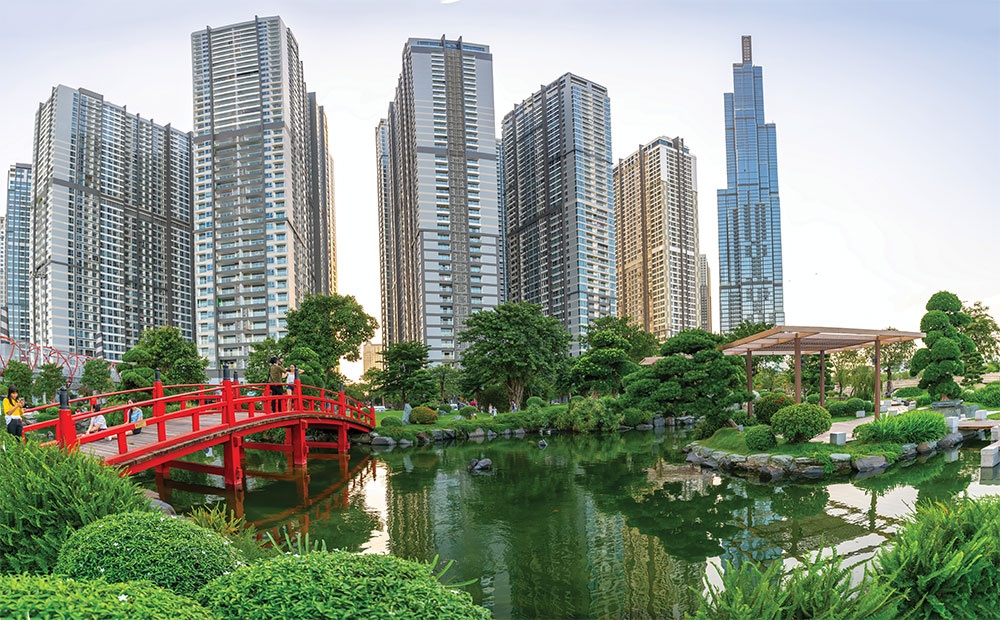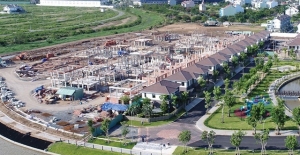Outlining Vietnam's urban identity
 |
| Dr. Ngo Viet Nam Son, chairman of NgoViet Architects & Planners |
According to a recent report by the Ministry of Construction, strong urbanisation in Vietnam has taken place in the past two decades. How do you assess the pace of urbanisation and urban development in Vietnam in recent years?
Vietnam has witnessed a fast pace of urbanisation and this is also an inevitable trend around the world as current economic development focuses mainly on urban areas. The pace of urbanisation is therefore usually proportional to economic development.
However, it is important to ensure swift and sustainable growth, meaning that to bring about socioeconomic development, urban planners must control environmental impacts at an acceptable level as would take a long time to tackle them, causing great waste to the economy and hindering development.
Have cities in Vietnam been developing sustainably?
It is difficult to judge whether Vietnamese cities are sustainable because this is a goal, rather than a state.
Every development has an impact on the environment, and there should be a balance in the process. Sustainability is not being greedy – that is, you must leave room and retain existing values, especially environmental ones.
In this regard, the sustainability factor in Vietnam is often disproportional to development, and the more cities in Vietnam, the more consequences begin to appear. In particular, Ho Chi Minh City is considered being the most developed in Vietnam, but it is also a place with many consequences such as traffic jams, flooding, lack of technical infrastructure, lack of social infrastructure, lack of schools, and more.
Why is that? As we grow up, the population density increases, the work density increases, and the need for technical and social infrastructure also increases proportionally. Sometimes people think only of their own interests while neglecting balance with other interests.
Thus, it should be said that urban development in Vietnam is increasingly unbalanced – the more developed areas are, the more unsustainable they become.
How do you rate a sustainable city?
To develop a sustainable city, we must meet many factors. First is to preserve existing values. These things relate to the environment, such as keeping or increasing the proportion of trees, rivers, and lakes, which must be kept clean and less polluted.
In addition, heritage values must be preserved such as architectural planning, historical heritage, or the works left to us by our ancestors. In order to keep the identity of an ancient city, it is necessary to clearly define its characteristics to give an appropriate development direction.
I once questioned whether there was a need for another Ho Chi Minh City-like destination in the Central Highlands, when I wrote an article about the development direction of Dalat. If you look at aerial photos, the centre of Dalat currently has the Governor’s Palace as the only green area, and the rest has been almost concreted.
Developing and increasing the living value in an area does not only embrace increasing construction density, modernising infrastructure, or looking at non-agricultural rate mechanically, but is also the need to increase green space, enhancing conservation, and promoting existing heritage values.
It is necessary to have a broader view so that some urban areas with specific characteristics of nature, cultural heritage and architecture still have appropriate mechanisms for urban development and receive preferential policies from the state.
Secondly, the sustainable value of a city is also related to planning and management. When developing, we will have available technical and social infrastructure in proportion to the housing size. There must be good planning and management.
Furthermore, development must also be geographically and regionally balanced, as well as not too concentrated in one place.
International studies indicate that liveable cities often have a low population, limited to fewer than three million people. If the city is too big, it will be complicated and the community lacks cohesion and identity.
Therefore, organising a central urban area connected to large and small cities would be much better than organising a considerable urban area.
For example, Paris is huge yet only accommodates two million inhabitants and few tall buildings, which facilitates cultural preservation. To enlarge a modern urban space, Paris proposed a neighbouring province of Hauts-de-Seine as a new downtown area. They formed an inner ring city consisting of Paris and three neighbouring cities to form a large metropolis.
This model can be applied in Ho Chi Minh City. Unlike the southern urban area that was proposed by overseas consultants, the Eastern City project is the first initiated by the municipal management authority.
This resembles a satellite town located in the inner-ring multi-centre city. The outer belt will be an urban cluster connecting the region with neighbouring provinces such as Ba Ria-Vung Tau and Tien Giang, with a system of radial roads and ring roads.
The satellite urban model is not a new creation. One should refer to districts 1 and 3 of Ho Chi Minh City, which feature European-style infrastructure attuned to the principle of ensuring all necessary technical and social infrastructures are provided within a walking distance.
 |
| A sustainable city must maintain and grow the ratio of trees and water surface |
Urban development has become an important driving force for socioeconomic development, but is subject to many risks due to global climate change. What is the root of the problem?
First off, planning is a science. When we develop an urban area, the housing rate should be commensurate with the traffic rate; social infrastructure, hospitals, and schools should all have relative proportions to ensure that all people can enjoy the facilities. If the planning was not scientific, it would leave great impacts, so that when approving the planning, this science must be ensured.
Once you have a plan, you must follow the plan. There are many cases where a project promises countless benefits when being approved. Later, upon implementation without having a good management, some investors can only do what they can sell, while ignoring the responsibility for building social infrastructure, leaving the burden on the state.
If we couldn’t manage it well, there might only have some living quarters where rooms are available, associated social infrastructure such as power lines, roads, schools, and stations are lacking.
The next aspect is coping with environmental impacts. For instance, important urban projects must complete environmental impact assessment reports, and the investors must be held socially accountable for their environmental impacts.
For example, an urban area is stable, with full infrastructure. If the investor proposes to build an apartment complex for 10,000 people, yet neglecting to upgrade the infrastructure, then when these people move in, they would cause serious overcrowding for that area.
Therefore, before licensing a project, it is necessary to assess the environmental impact carefully; if not, there are only two options: stop the project or ask the investor to upgrade associated social technical infrastructure.
Legal background is also crucial. Many urban areas have been developing in the wrong direction, but we can’t do anything due to the lack of good legislation, as seen with the phenomenon of greenhouse building in Dalat.
On Dalat’s agricultural land, many areas are now covered with greenhouses. Many are unknown that greenhouses cause the same effect as concrete houses, causing water to drain too quickly to the lowlands, leaving Dalat to fall into temporary flooding state this late year period.
From a scientific perspective, you have to treat the greenhouse like a concrete building. Currently, urban residential land is often built at the rate of 30-40 per cent, the rest is for roads, infrastructure, and green construction.
Thereby, there need to be apparent regulations on building greenhouses on agricultural land which should not exceed 30 per cent of total land area and must be accompanied by a drainage system connecting to the common system; the design must be beautiful, and harmonising with the general landscape.
How do you envision Vietnam’s urban future in the next decade?
For future development, we would need both long-term and short-term development planning.
In the long term, we now have planning schemes for the next 30 years, but in my opinion, the planning must embrace a vision for the next 50-100 years, or even beyond.
For example, Vietnam is being severely affected by climate change with rising sea levels. Future development trends must then give priority to development in the highlands.
Development should be limited in lowland areas, and a lot of land should be reserved for green space and water surface. This would help save on money as it takes a long time to overcome flooding, greatly affecting the economy.
Along with the embellishment of existing urban areas and development in all directions, development in highland regions should still be given top priority.
In the short term, weak points in existing legal framework for sustainable urban development need to be soon adjusted by relevant authorities.
It is necessary to have in place practical policies to promote green urban development, such as annual tax reduction for investors using green and renewable energy, or developing technical and social infrastructure for the community.
There must also be heavy fines imposed on investors and managers not compliant with the planning, causing traffic jams and flooding, exacerbating the burden on the state budget in dealing with such consequences.
 | Urban dwellings to become property market core in 2023 This was stated by Le Viet Hai, vice president of the Saigon Construction & Building Material Association (SACA), during the Dynamics of Vietnam's Economic Development 2023 seminar held on December 14 in Hanoi. |
 | Ho Chi Minh City suburban real estate market set for revival After a lengthy period of inactivity, the real estate market in and around Ho Chi Minh City is resuming deals, mostly in new full-scale developments. |
 | 96 per cent of urban household wastes to be safely processed in 2023 Vietnam targets having 96 per cent of urban household wastes collected and processed up to standards this year, said Director of the Ministry of Natural Resources and Environment’s Vietnam Environment Administration Hoang Van Thuc. |
 | Keppel Land and Khang Dien Group collaborate on sustainable urban developments Keppel Land, through its wholly-owned subsidiary, and the Khang Dien Group, signed MoU on 10 February to collaborate on the development of residential projects as well as sustainable urban developments in Ho Chi Minh City. |
What the stars mean:
★ Poor ★ ★ Promising ★★★ Good ★★★★ Very good ★★★★★ Exceptional
Related Contents
Latest News
More News
- Sun Group breaks ground on $2 billion Van Don casino complex (December 19, 2025 | 18:14)
- Rare, beautiful, sustainable: the mark of iconic real estate (December 19, 2025 | 08:00)
- Owner-occupied housing stabilises, paving the way for new growth cycle (December 18, 2025 | 17:04)
- Unlocking urban potential of smart cities (December 18, 2025 | 16:50)
- Green finance offers 'passport' for Vietnamese construction, building materials firms (December 15, 2025 | 08:00)
- Gamuda Land commit long-term investment (December 12, 2025 | 11:49)
- HITC ties up with Evolution to develop AI and hyperscale data centres in Vietnam (December 11, 2025 | 12:09)
- Real estate deals boom via high-profile names (December 08, 2025 | 11:32)
- Industrial segment shaped by M&As (December 08, 2025 | 08:00)
- The Privé sets the benchmark for luxury real estate (December 05, 2025 | 08:28)

 Tag:
Tag:




















 Mobile Version
Mobile Version